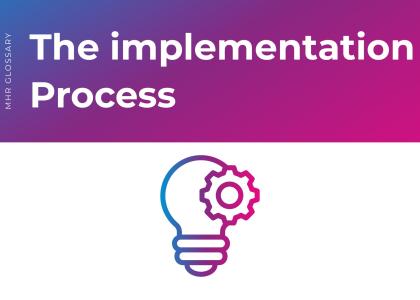Step 1: Build a plan
Any HRIS implementation starts with identifying a need. This could be anything, from security concerns about a legacy system, to a lack of supplier support, to simply changing attitudes to best practice. The cloud has become a much bigger draw for many organisations, and digital transformation is at the forefront of everyone’s minds. Either way, you’ll come to the conclusion that how things are currently done isn’t quite working or could be a lot better.
Once you’ve identified where improvements can be made (usually by asking questions like ‘who’s using the current system, and what needs do they have?), it’s time to put together a business case. Not only will this be used to show other people in the organisation why the upgrade is important, it will help you flesh out your plan. It gives you a point to refer back to, which can be incredibly useful when things get complicated. It will also help you figure out the best solution available, as you’ll have a clearer picture of your actual needs.
Any strong business case should follow these six steps:
- Identify the challenges
- Describe how this impacts your team
- Provide evidence, such as key metrics and data
- Propose the solution and timeline
- Outline potential costs
- Spell out the potential ROI
This will ensure you can more easily build up stakeholder buy-in and get the investment you need to ensure the project is a success.
Your planning should also factor in a switchover day. This doesn’t have to be set in stone, and it should absolutely account for unforeseen events, but having something firm to work towards is incredibly helpful.
Step 2: Tidy up your data
You likely have a lot of data built up over years of using your old system. A lot of that won’t be necessary for you new system. Yet some implementation processes have you bring everything over. What’s the point? Take some time to go through and evaluate your HR and payroll data. What do you need to bring over, what can stay behind?
You should always make full backups of the entirety of your current data. That way if something goes wrong, you can always restore to a safe point.
Do note that there are some records you’ll need to keep for a long time. You may not need to bring them into the new system, but you will need to safely archive them for future use.
Step 3: Install and configure
This is where you make sure that your system is set up in the right way for your organisation. We’ll work with you to set up your core processes and ensure anything that’s unique to your business is also accounted for. It’s impractical to find a system that perfectly suits everything you need straight out of the box. Our expert HR, payroll, and technical consultants are focused on providing advice, guidance, support, and knowledge transfer of People First to give your project team confidence in using your chosen solution. Our consultants are system experts that will operate to MHR best practice to ensure everything works for you.
People First uses a modular system where you can add extra features to a core HR system, which makes configuring to your needs much simpler. The implementation will approach each module at the right time for you and we will identify key stakeholders to engage at each relevant phase. Such stakeholders include HR managers / administrators, recruitment and L&D Specialists, finance and IT representatives and key managers from across the business.
Remember, it’s always worth adapting your existing processes to fit the system, rather than trying to force the system to fit your processes. Otherwise, there’s not much point migrating in the first place.
Step 4: Test
Testing is vital to a successful HR system implementation. For our purposes, there are two main kinds of testing to consider.
Configuration testing is where you make sure your data has imported correctly, and all your workflows are operating as you expect.
Functionality testing is where you see how your processes interact with the system. Does it work as intended?
The more you do this both during and after implementation, the more successful things will be. Many organisations like to run their new system in parallel with the old one for a few months. While this may lead to extra work in the short term, it provides extra certainty that you’re not going to be caught short.
Step 5: Build buy-in
You can use the single greatest system in the world, but if nobody in your organisation cares to use it, then it’ll just sit around gathering dust. You need to create buy-in among your key stakeholders across the entire organisation, particularly those who are going to be using it on a daily basis! Onboarding and training are both very important.
The best way to do this is through software ‘champions’. These people will take an active role. Train them up first and they’ll spread that information throughout their teams and beyond. They’ll become your staunchest advocates.
When picking your software initially, there would have been some key issues that you were grappling with, and some key benefits that drew you in. What problems did you have with the old system? What will the new one help with? Convey this to the wider team, and they’ll get excited too.
MHR offers LearnNow for anyone looking support in implementing and onboarding people onto People First. With tailored sessions built around your implementation, it makes it simple to get key stakeholders up to speed on what they need to know.
Step 6: Rollout the system
This is also your chance to refine the system further. Don’t just implement the system and then leave it to flounder. Solicit regular feedback and get a sense of how the rollout has gone, whether any adjustments should be made, and how the system is meeting your initial KPIs. You can track things like usage data, which means you can more easily spot any issues and put support out there.
Don’t just do this once and call the matter done. You should create an ongoing culture of feedback. That will ensure you can have a productive conversation with your provider, and you don’t get stuck in the same position you started with. Make the most of any customer support options provided to you, especially consultancy and change management services, and these will help you stay coordinate and stay on top of any new developments.
Want even more details about how to get a smooth and seamless implementing process with MHR’s system? We’ve been supporting a huge range of organisations implement our systems and can help you find your way through the whole process. Check out our migrate without the migraine guide for HR and payroll systems for more details.



